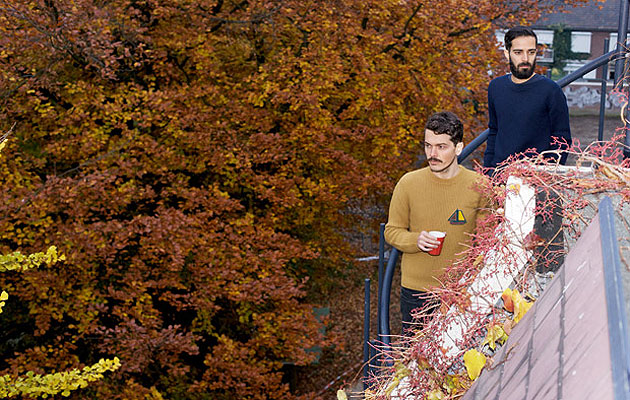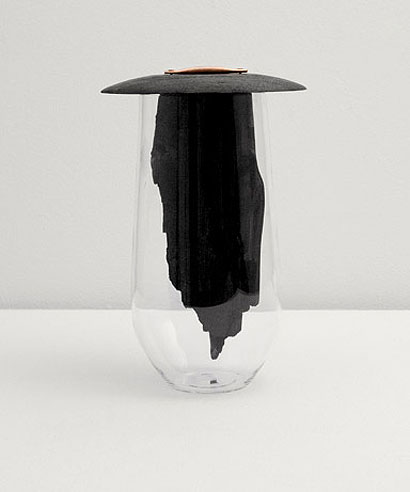|
|
||
|
“Ghost shapes” is how Andrea Trimarchi and Simone Farresin translate the name of their Eindhoven-based studio Formafantasma. It’s a neat way of describing the historical references in the Italian designers’ work: trawling the past for potential discoveries, they use forgotten materials and processes to add new meaning to contemporary design. Icon’s first encounter with the pair was in 2011, in the vaults of Milan’s Spazio Rossana Orlandi. Shuffling around the gallery’s packed subterranean spaces, visitors met the strange sight of Botanica, Formafantasma’s collection of vases made from pre-industrial plastic. The output of research into 18th-century plant, insect and animal-derived polymers, Botanica imagined what plastic might be if oil had never been discovered.
This year Formafantasma returned to the past for Fendi. Asked to make a collection from the fashion house’s leather offcuts, Trimarchi and Farresin looked into alternative “leathers”, too: vegetal-dried fish skins, pig skins and even cow bladders. “We were interested in this idea of the exotic,” Farresin says. “Often with high fashion there is this search for the exotic or the extraordinary. And we wanted to get the same result, but instead use the really common.” Farresin says the intention of this project, Craftica, was not to shock, but to spark our imaginations. With Botanica, too, the designers demonstrated a talent for elegantly defying conventions and unravelling years, even centuries, of common perceptions about what materials are and do. “You can do it with an image,” he says. “But people are so used to seeing those. When you play with a material, you have to really intervene in the production process. That way you have a much deeper impact on the way people perceive it.” Vitra invited Formafantasma to Switzerland this year to make pieces in charcoal for the exhibition Confrontations. Paired with a producer who makes charcoal in a traditional way by charring wood in a branch-covered mound deep in the Swiss forest, the designers again found a new expression for an ancient material. “Charcoal has this image of something that is dirty or used for fuel,” Farresin says. “But it’s also used to purify water and air.” The project, a collection of glass and charcoal vessels, was about pairing these aspects of the material. Some charcoal forms are smoothed to the point where the material becomes unrecognisable, while others are left jagged, like shards of rock. “Using charcoal to purify is not new, but we wanted to make it bolder, more visually overwhelming. There’s almost something romantic in the way it looks. The fascination for nature is there.” While in its work it plays with elements of folk, craft and traditionalism, Formafantasma cautions against taking too romantic a view of such processes. The forest-based method of creating charcoal was largely banned in the 20th century because of problems with pollution and deforestation, and it is now only done in a kind of ritual context at festive events. Along with the vessels, a set of charcoal drawings were made to present this alternative narrative. “Images of trees burning, polluted waters … a way of showing the complexity of our relationship with tradition,” Farresin says.
It’s not all serious though. A pack of playing cards recently won Formafantasma a souvenir design competition set by the Vienna Tourist Board. The cards’ minimal graphics portray aspects of Viennese life and culture. Farresin says: “First we thought, ah, we hate souvenirs. They’re unsustainable and they’re gimmicky. But then we started thinking about undoing the cliché and went from there.” The studio has also been asked to add new pieces to Magis’s children’s collection in time for Milan Furniture Fair – its first experience of working with one of the Italian manufacturing greats on a mass-produced scale. For such an experimental studio, the move to mainstream industrial design is a surprise. How does the fast world of commercial design sit with Formafantasma’s slow-burning, research-led ethos? “I think it will be really different to what we have done so far,” Farresin says. “But we feel it’s an important step. Designers need to be able to fit their vision with the vision of a company too. [In these cases] it’s not so much about us any more.” Establishing a dialogue with the big manufacturers is a learning process. Farresin compares the initial stages of working with Magis to “two animals seeking to understand each other”. The courting ritual may begin with a knock on the door by the company but “it’s you that is entering their world. They are the ones with much more experience and it takes time to find out what your abilities are within that context.” In parallel with these new ventures, Formafantasma already has a full calendar of other collaborations for the year ahead that will see the studio develop existing themes. In February, it will realise an exhibition for the Textile Museum in Tilburg in the Netherlands dedicated to the colour red. Delving into the museum’s archives, Formafantasma found a set of historical books donated by a prominent textile-making family from the area. “The books tell you all about printing techniques and the textiles they collected from all around the world, but also about the family and the people that worked for them,” says Farresin. One family member had documented his experiments to create a particular tone of bright red – Turkish red made from the madder root (rubia tinctorum). The history of making this colour and the migration of the dying process from Persia to Europe will be the basis of the show – a subject that takes them back to their earlier textile studies Colony and Migration (2011). Formafantasma is celebrated in this issue as a pair of exceptional emerging designers with a body of work that is as stimulating conceptually as it is visually. But do they see themselves as emerging designers? “Yes I think so,” Farresin says. “Obviously we don’t talk about ourselves in this way, but it’s a feeling we have every time we sit down to work. We’re often working on so many things that we never have the feeling of being accomplished at anything!” |
Image Boudewijn Bollmann; Luisa Zanzani
Words Riya Patel |
|
|
||





















